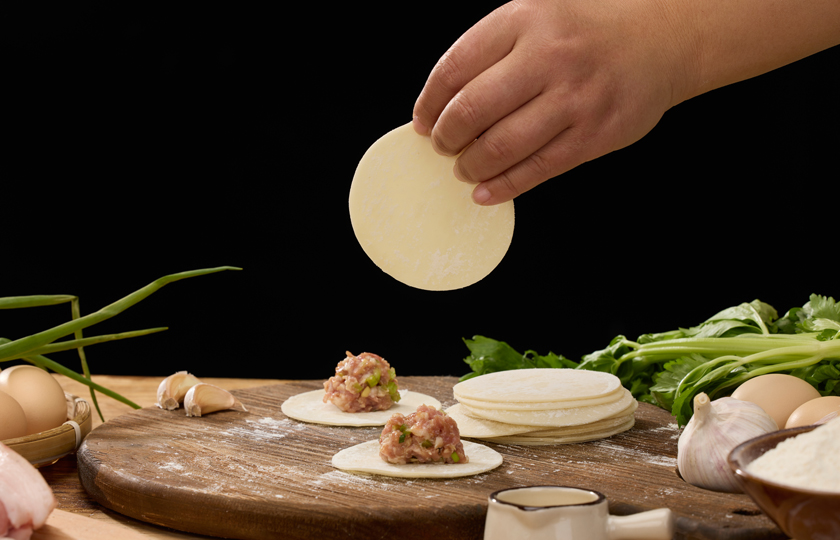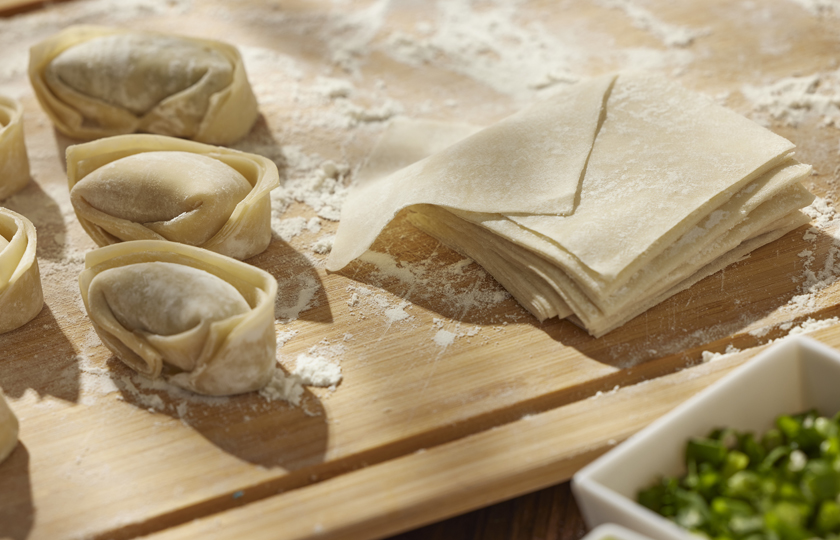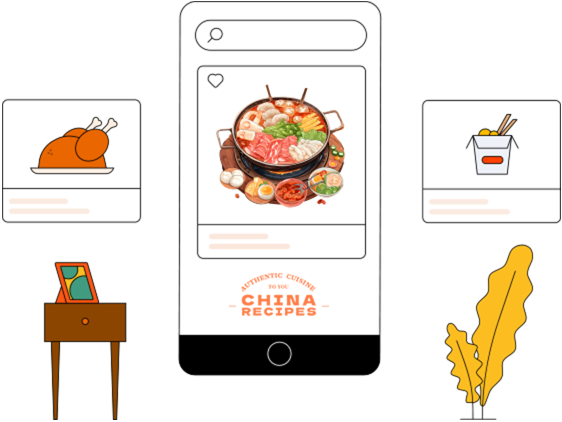The Difference Between Wonton and Dumpling Wrappers: Everything You Need to Know

As representatives of Chinese cuisine, both wontons and dumplings are deeply loved by everyone. However, their "outer layer" - wonton wrappers and dumpling wrappers, actually have differences.
Difference 1: Shape and Size - The "Philosophy of Dough Wrappers" of Square and Round
The Key to Identifying at a Glance:
Wonton wrappers: Mostly square (with a side length of 7 - 8 cm) or rhombus (common in the south). The edges are sharp. When folding, they are suitable for pinching diagonally or rolling into an ingot shape.
Dumpling wrappers: Standard circular (with a diameter of 8 - 10 cm). The arc-shaped edges can more easily enclose spherical fillings, and the dumplings made look like crescent moons.
Why is the shape important?
It's easy to break a square wrapper when wrapping large meat fillings, while a round wrapper can naturally fit the arc of the filling. Next time you make dumplings, try using wonton wrappers - either the filling will be reduced in quantity, or the wrapper will burst, and then you'll understand!
Difference 2: Thickness and Texture - As Thin as a Cicada's Wing vs. Flexible and Chewy
The Battle between Touch and Taste:
Wonton wrappers: So thin that light can pass through (1 - 1.5 mm). They almost dissolve when put into the pot and become semi-transparent after cooking. The texture is like silk sliding across the tip of the tongue, making them suitable for soups.
Dumpling wrappers: Thick and chewy (2 - 3 mm). They remain tough after steaming, and the bottom becomes crispy after frying. They can withstand high-intensity cooking methods (such as pan-frying and boiling).
Scientific Principle:
Wonton wrappers have a high water content and a short kneading time, resulting in a sparse gluten network. Dumpling wrappers require repeated kneading and pressing, along with using hot water to knead the dough, which activates the gluten proteins and forms a "spring structure".
Difference 3: Ingredients and Techniques - The "Molecular-Level Differences" from Flour to the Finished Product
Secrets of the Recipe and Techniques:
Wonton wrappers:
Ingredients: High-gluten flour (or bread flour), water, salt. Some southern recipes add egg yolks (to enhance color and flavor).
Techniques: Knead the dough less and let it rest less. When rolling, ensure the thickness is uniform to avoid excessive gluten formation.
Dumpling wrappers:
Ingredients: Medium-gluten flour, hot water (to activate the gluten), and alkaline water (in northern recipes, such as for alkaline dumpling wrappers).
Techniques: Knead the dough for more than 10 minutes and let it rest for 30 minutes. When rolling the wrapper, it should be thicker in the middle and thinner at the edges.
Home Practice Suggestions:
Wonton wrappers can be easily made with a pasta machine. For dumpling wrappers, you can use the method of "pressing first and then rolling" - first flatten the dough with a rolling pin, and then roll the edges while rotating.
Difference 4: Cooking Methods - The "Survival Test" from Clear Soup to Grilling
The Love-Hate Relationship between the Dough Wrapper and the Heat:
Wonton wrappers:
Ideal Combinations: Clear soup, rich stock (such as for wonton noodles), deep frying (fried wontons), steaming (shrimp wontons).
Fatal Weakness: They will become mushy if cooked for more than 5 minutes. When deep frying, they need to be fried at a low temperature and slowly to prevent bursting.
Dumpling wrappers:
Diverse Cooking Methods: Pan-frying (pot stickers), boiling (boiled dumplings), steaming (steamed dumplings), freezing for later use (cook as needed).
Pressure Resistance Test: When pan-frying pot stickers, first fry and then simmer. The wrapper will not break or leak, and the bottom will be crispy and fragrant.
Chef's Tips:
Want to make wonton wrappers crunchier? Deep fry them directly after freezing - when ice crystals turn into vapor upon heating, the wrapper will instantly puff up like a thousand-layer pastry!
Difference 5: Regional Characteristics - The "Battle of Dough Wrappers" between the North and the South
Each Region Nurtures Its Own Dough Wrapper:
Northern dumpling wrappers: Thick and suitable for cold weather. Paired with cabbage and pork fillings, a bite will release a burst of soup, corresponding to the bold eating style in the north.
Southern wonton wrappers: Thin, light, and transparent. Paired with shrimp and bamboo shoot fillings, they are in line with the delicate style of Cantonese dim sum.
Japanese dumpling wrappers: Somewhere in between (thicker than wonton wrappers but thinner than dumpling wrappers), suitable for the culture of pan-fried dumplings, aiming for a balance of crispy exterior and soft interior.
Interesting Fact:
The wrapper of Shanghai xiaolongbao is an "evolved version of wonton wrapper" - slightly thicker than an ordinary wonton wrapper but thinner than a dumpling wrapper. After steaming, it shows the luster of the meat juice, and can be regarded as the "hexagonal warrior" in the world of dough wrappers.

Can wonton wrappers be used to replace dumpling wrappers?
If you are just making an occasional attempt and not very picky about the texture of dumpling wrappers, wonton wrappers can be used to make dumplings.
Since wonton wrappers are thinner, the amount of filling should be appropriately reduced when wrapping, otherwise the wrapper is likely to break.
Moreover, the cooking time for dumplings made with wonton wrappers should be shortened to prevent them from getting overcooked.
However, wonton wrappers cannot completely replace the thick and chewy texture brought by dumpling wrappers. Therefore, when making traditional dumplings, it is still recommended to use special dumpling wrappers. But in creative cuisine, such as making mini dumplings or crispy fried dumplings, wonton wrappers can bring unique textures and visual effects.
Are wonton wrappers the same as spring roll wrappers?
No.
Although both wonton wrappers and spring roll wrappers are pasta products, they are not the same.
Spring roll wrappers are thinner and larger than wonton wrappers. They are generally rectangular, with dimensions of approximately 20 - 25 cm in length and 15 - 20 cm in width.
The production process of spring roll wrappers is more complex. Usually, the method of "flying the dough" is adopted, where the dough is quickly rotated and spread on a hot flat pan to form an extremely thin and highly resilient dough wrapper.
Spring roll wrappers have a crispy texture and are suitable for frying, forming a golden and crispy outer shell.
On the other hand, wonton wrappers have a smooth and delicate texture and are mainly used for boiling or in soup-based dishes.
Where can I buy wonton wrappers?
Generally, you can find wonton wrappers in the following places:
Asian supermarkets: In most Asian supermarkets, they can usually be found in the refrigerated section or the pastry area.
Online shopping platforms: For example, on platforms such as Amazon and eBay, many sellers offer different brands of wonton wrappers.
Local Chinese restaurants or pastry shops: Some restaurants also offer homemade wonton wrappers. If it is inconvenient for you to make them yourself, you can also buy the ready-made ones directly.
When to choose which wrapper?
Choose wonton wrappers for: Wonton soup, crispy fried wontons, transparent steamed dumplings (such as Guangdong shrimp dumplings).
Choose dumpling wrappers for: Pan-fried dumplings, boiled dumplings, steamed dumplings (such as Northeast sauerkraut dumplings), freezing for later use.























